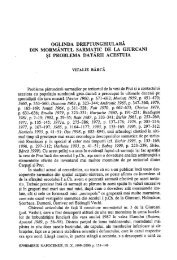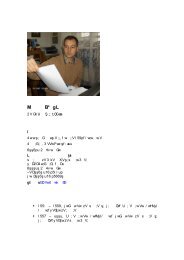EPHEMERIS NAPOCENSIS - Institutul de Arheologie Åi Istoria Artei
EPHEMERIS NAPOCENSIS - Institutul de Arheologie Åi Istoria Artei
EPHEMERIS NAPOCENSIS - Institutul de Arheologie Åi Istoria Artei
Create successful ePaper yourself
Turn your PDF publications into a flip-book with our unique Google optimized e-Paper software.
Instrumentum Balnei from Roman Napoca<br />
237<br />
exception of a bronze plate which was set into the rim (Pl. V/1). The bronze plate, representing<br />
the fixed part of the closing system, displays two holes: an oval one positioned near<br />
the rim (D: 9.4–10.7 mm) which allowed the liquid to exit and a small, circular central one<br />
(D: 2.6 mm) which was used for fastening another mobile metal plate (lost today). This in<br />
turn, provi<strong>de</strong>d with two small knobs, displayed a similar opening as the above mentioned oval<br />
one and sealed its counterpart from the set plate by rotation. The vessel was recovered from<br />
the excavation in a bad state of preservation (strongly oxidized, <strong>de</strong>formed body, base broken<br />
from the body and fragmented in three parts) (Pl. 1/2). For this reason during the restoration<br />
process, in or<strong>de</strong>r to ensure its stability, it was covered in some parts with a thick layer of<br />
resin, process which <strong>de</strong>termined important changes from the original shape, especially in the<br />
area of the rim and of the base. In this situation, in or<strong>de</strong>r to reconstruct the original shape<br />
of the vessel as accurately as possible, the technique of X-ray photography was employed<br />
(Pl. IV/1–2). It can be observed very well that the exterior part of the rim was not straight,<br />
but slightly reverted and that the original base had a smaller diameter than the one obtained<br />
after restoration and it was less flared (Pl. IV/2). The X-ray offers also important <strong>de</strong>tails about<br />
the technology employed in the manufacturing process of the vessel: the body was ma<strong>de</strong> from<br />
two hemispherical parts joined in the point of the maximum diameter. The two joining lines<br />
visible in the area of the rim show that this part was worked separately and subsequently<br />
attached to the body; the rim, at its turn, was ma<strong>de</strong> out of two pieces of metal separated by<br />
the bronze plate. It is not certain whether the base was also separately ma<strong>de</strong> or it was part of<br />
the lower hemisphere. Taking into account that it was found broken and reattached during<br />
restoration, this remains for the moment an open question.<br />
The second vessel (Pl. VI/1, VIII/1a–d, IX/1a–d, 2, 3) (National History Museum<br />
of Transylvania, Cluj‐Napoca, without inventory no.) was i<strong>de</strong>ntified in room b, consi<strong>de</strong>red<br />
to be an annex 17 belonging to the 2 nd phase of house C2 (Pl. II). The vessel was found on<br />
the first floor near the place where the monetary hoard was hid<strong>de</strong>n, together with a group of<br />
metal objects: two bronze vessels (a jug of Millingen type and a handle from a Blechkanne),<br />
two bronze candlesticks, a bronze statuette <strong>de</strong>picting a ram and several pieces of bronze sheet<br />
with figural <strong>de</strong>coration 18 . It is not clear whether the objects were intentionally collected and<br />
hid<strong>de</strong>n or they were kept in a woo<strong>de</strong>n chest or cupboard which was abandoned in a time of<br />
danger. Thus, relying on the stratigraphic data, it can be asserted that the vessel was certainly<br />
in use in the first half of the 3 rd century AD. The object ma<strong>de</strong> entirely of iron, was discovered<br />
in a fragmentary state (Pl. IX/2–3), one of the handles was missing and it was reconstructed<br />
during restoration. It presents a vertical rim, a narrow neck and a spherical body. It does not<br />
have a base and the lower part of the body is slightly elongated, ending in a small protuberance.<br />
The original handle, attached below the rim and ending with a leaf shaped appliqué,<br />
still preserves half of a loop which was part of the hanging chain. It displays the following<br />
dimensions: H: 100 mm; maximum body D: 82.8 mm; rim D: 38.9–41.6 mm and it weighs<br />
259 g. The lid seems to present a similar system to the one <strong>de</strong>scribed above: an upper mobile<br />
plate presenting two knobs and a lower, fixed one. Since the vessel was restored it is not<br />
possible anymore to observe the two oval openings that the plates should have had. Still,<br />
based on the information offered by the X-ray (Pl. VII/1–2) it looks like the whole lid system<br />
was worked separately and afterwards fitted insi<strong>de</strong> the rim. Even if not very clear, the X-ray<br />
seems to show a shallow line which could mark the limit between the plates. Concerning the<br />
manufacturing process, besi<strong>de</strong>s the handles and the lid, the body of the vessel was ma<strong>de</strong> from<br />
two different parts, an upper one together with the rim and a lower one, which are joined<br />
above the line of the maximum diameter.<br />
17<br />
OPREANU 2008, 393.<br />
18<br />
COCIŞ ET AL. 1995, 637–638.















